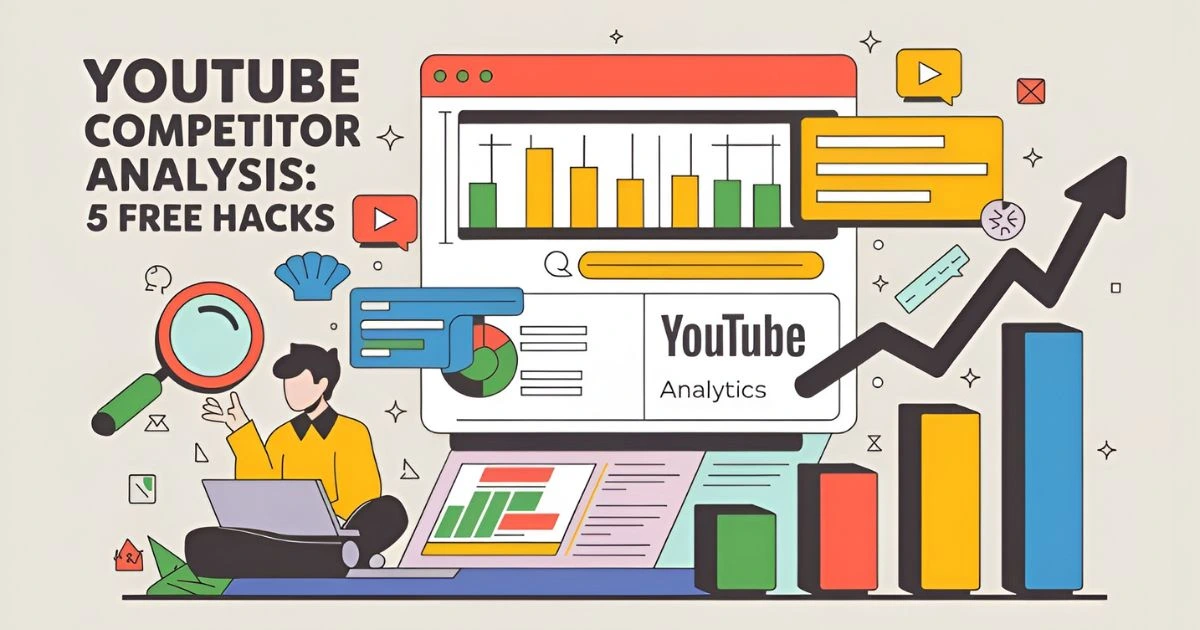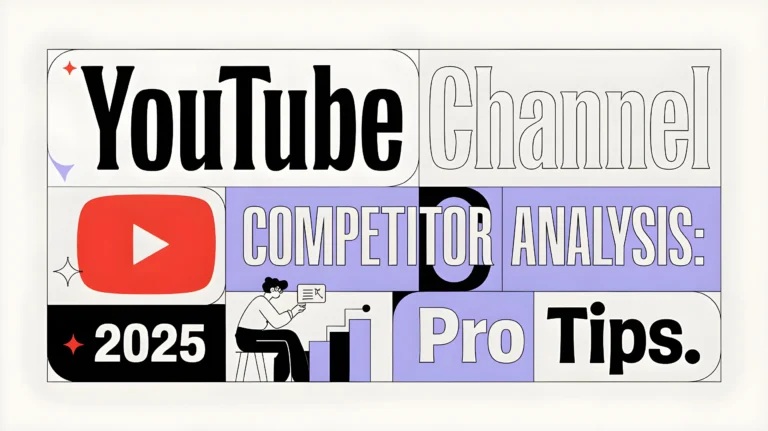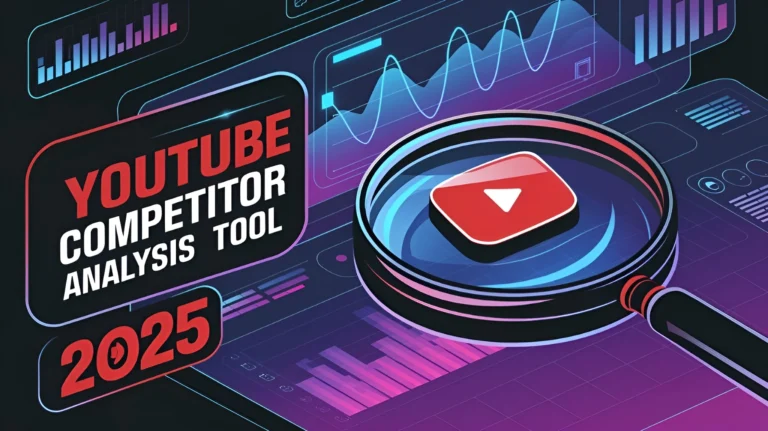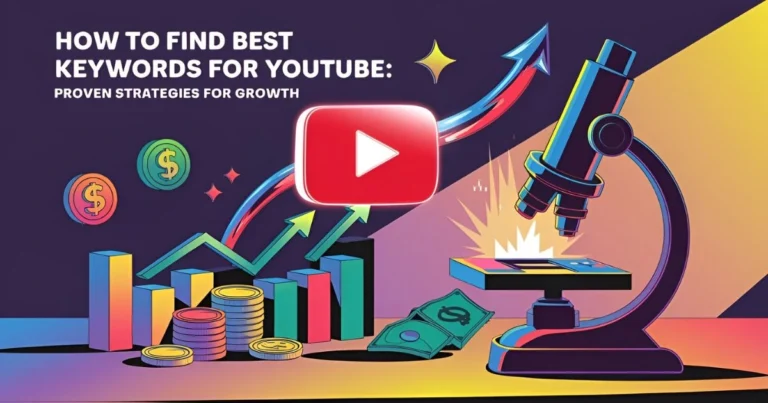YouTube competitor analysis is the hidden engine behind every successful channel in 2025. Success on YouTube isn’t about luck or guesswork – it’s about understanding exactly what drives your competition to the top.
Table of Contents
The platform has evolved far beyond simple video sharing. With millions of creators fighting for attention, standing out requires more than just quality content. It demands a deep understanding of what works in your niche. The difference between viral success and obscurity often comes down to knowing precisely what strategies drive your competitors’ growth.
Imagine having a guide that shows how top creators win. That’s what YouTube competitor analysis gives you. By studying successful channels, you’ll find out what makes their content go viral.
Understanding YouTube Competitor Analysis Fundamentals
YouTube competitor analysis is like finding a secret path to success. It helps you track and analyze your rivals. This way, you get insights that can make your content better.
It’s not just about watching what others do. It’s about understanding their secrets. By studying their moves, you can find new ways to grow and stand out.
Key Metrics That Define Success
Knowing the right metrics is key for YouTube success. Here are the top ones:
- Total view count
- Watch time duration
- Subscriber growth rate
- Average view duration
- Audience retention percentage
Tools for Tracking Competitor Performance
For YouTube analysis, you need the right SEO tools. Social Blade and YouTube Analytics are great. They give you deep insights without needing to be a tech expert.
| Tool | Pricing | Number of Users | Rating (out of 10) | Beginner Friendly | Free Version |
|---|---|---|---|---|---|
| TubeBuddy | Free; paid plans start at $9/month | Over 10 million users | 9/10 | Yes | Yes |
| VidIQ | Free; paid plans start at $7.50/month | Over 1 million users | 8.5/10 | Yes | Yes |
| Noxinfluencer | Free plan with limited features; paid plans start at $49/month | Over 10 million users | 8/10 | No | Yes |
| Social Blade | Free; premium plans start at $3.99/month | Over 7 million users | 7.5/10 | Yes | Yes |
| SEMrush (YouTube Analytics Feature) | Free trial; paid plans start at $119.95/month | Over 7 million users | 9/10 | No | Yes |
Leveraging YouTube Analytics for Strategic Insights
Understanding YouTube analytics is key to beating your competitors. It helps you make smart content plans. Your channel’s success comes from using data well.
YouTube Analytics is full of useful info to boost your content. It shows you what viewers like and who they are. This helps you make better content.
- Explore audience retention graphs to understand viewer engagement
- Track traffic source percentages for targeted content distribution
- Analyze viewer demographics to refine content targeting
Important metrics to look at include:
- Watch Time: Shows how good your content is
- Click-Through Rate (CTR): Tells you if your titles and thumbnails work
- Audience Overlap: Finds who you can work with
Creating a strong content plan means watching your analytics closely. You’ll learn what your viewers like. This helps you make videos that grow your channel.
Top creators use YouTube Analytics to get ahead. They turn data into advantages that make their channels stand out.
Decoding Your Competitors’ Content Strategy
To master YouTube competitor analysis, dive deep into what top YouTube creators do in your niche. Analyzing your competitors can reveal powerful insights. These insights can greatly improve your channel’s performance.
For example, imagine a cooking channel that’s stuck at 5,000 subscribers while similar channels reach 100,000+. Through YouTube competitor analysis, they discover that successful cooking channels post shorter, recipe-focused videos under 5 minutes instead of lengthy cooking vlogs. They also notice these channels use custom thumbnails showing the finished dish with bold text overlays. After applying these insights, their channel starts growing faster than ever.
Find Your Top Competitors
- Search for your main keywords on YouTube
- List channels with similar content but higher subscriber counts
- Focus on channels that have grown in the last 6 months
Study Their Best-Performing Videos
- Sort their videos by “Most Popular”
- Write down common patterns in titles and thumbnails
- Note video length and posting frequency
Analyze Their Content Structure
- Watch their top 10 videos carefully
- Notice how they start and end their videos
- Look for repeated segments or formats
Track Their Engagement Patterns
- Read comments on their most popular videos
- Notice which types of content get the most likes
- See how they interact with their audience
Identifying Content Themes and Patterns
YouTube competitor analysis helps reveal winning content themes in your niche. Successful creators typically follow specific patterns that resonate with their viewers. Look at these proven strategies:
- Perform YouTube competitor analysis on top-ranking videos to understand what drives their success.
- Monitor how competitors group related topics into cohesive series.
- Study which elements consistently spark high viewer engagement.
Tracking Upload Frequency
Being consistent is key to growing your YouTube audience. Look at how often your competitors post. This can help you plan your content better.
| Competitor Category | Average Weekly Uploads | Typical Content Length |
|---|---|---|
| Tech Reviewers | 2-3 videos | 10-15 minutes |
| Educational Channels | 1-2 videos | 15-20 minutes |
| Entertainment Channels | 3-4 videos | 5-10 minutes |
Thumbnail Design Strategies
Thumbnails are your video’s first look. Analyzing competitors shows what grabs viewers’ attention:
- Use high-contrast color schemes
- Include human faces with clear emotions
- Incorporate text that sparks curiosity
By studying and applying these insights, you can make your YouTube content more engaging. This will help your videos stand out in a busy online world.
Maximizing Video SEO Through Competitor Research
Learning how to do youtube competitor analysis is key to getting your videos seen more. By studying what your rivals do well, you can make your content better. This can help your videos rank higher.
First, do a deep dive into the top youtube channels in your field. Check out their video details, like:
- Keyword-rich titles
- Detailed descriptions
- Strategic tag selections
- Transcript optimization
There are free tools to help you explore your competitors’ keyword plans. Google Keyword Planner and YouTube’s Search Suggestions show you what works. See the exact words your competitors use to grab viewers’ attention.
Your video’s transcript and closed captions are very important for YouTube SEO. Search engines read this text, helping your video get found. Make sure your transcripts are accurate and full of keywords to boost your video’s search ranking.
Here are some key steps to help you with YouTube competitor analysis:
- Find out what keywords your competitors rank for
- Look at how they structure their metadata
- Study what makes their content successful
- Keep an eye on how people interact with their videos
Remember, the goal of youtube competitor analysis isn’t to copy them. It’s to learn and make your content even better. Use what you learn to create videos that are more likely to be found and watched.
Unlocking Engagement Metrics That Drive Rankings
YouTube engagement metrics are key for creators wanting to boost their channel. They help understand what viewers like and dislike. This knowledge can change how you make content and help you rank higher.
Through detailed YouTube competitor analysis, you can unlock the secret sauce that top creators use to dominate their niches. Don’t just chase vanity metrics – dive deep into what makes your audience tick, study what your competitors are doing right, and use these insights to build an unstoppable channel. The path to YouTube success is paved with data-driven decisions, and those who master this win big.
Watch Time Optimization Strategies
Watch time is very important to YouTube’s algorithm. To improve this, try these strategies:
- Create compelling video introductions
- Deliver high-value content within the first 15 seconds
- Use storytelling techniques to maintain viewer interest
- Implement pattern interrupts to prevent viewer fatigue
Audience Retention Tactics
To keep viewers, design your content carefully. Aim to keep them watching until the end.
| Retention Technique | Impact on Engagement Metrics |
|---|---|
| Teasing future content | Increases anticipation and watch duration |
| Using visual transitions | Maintains viewer attention |
| Adding strategic b-roll | Reduces monotony |
Comment Section Analysis
The comment section is full of insights. By analyzing comments, you can learn what viewers like and dislike.
Mastering these engagement metrics can boost your YouTube rankings. It also helps you build a loyal and connected audience.
Strategic Content Monetization Techniques
To make your YouTube channel profitable, you need smart strategies. Successful creators know it’s not just about ads. They find many ways to make money that fit their content and keep viewers coming back.
- YouTube Partner Program revenue
- Sponsorship opportunities
- Affiliate marketing
- Channel memberships
- Merchandise sales
Start by knowing what your viewers like. Look at who they are, what they’re interested in, and how they interact with your videos. Good content is the base of making money.
Try different ways to make money to earn more. Many top creators mix different methods to make a strong income plan.
| Monetization Channel | Average Revenue Potential | Audience Engagement Level |
|---|---|---|
| Ad Revenue | $3-$5 per 1000 views | Medium |
| Sponsorships | $500-$5000 per video | High |
| Affiliate Marketing | 5-30% commission | High |
| Merchandise | $10-$100 per item | Very High |
Content monetization keeps changing. Keep trying new things, watch how they do, and change as your viewers do. Your goal is to make money without losing the quality and realness of your content.
Advanced Channel Optimization Strategies
Mastering YouTube channel optimization needs a smart plan. This plan should include looking at what your competitors do. Your goal is to make your content so good that people keep coming back.
Top YouTube creators know how important layout and structure are. They study the best in their field to make their own strategy work.
Playlist Structure Analysis
Smart playlist structures can really help your channel. Here are some tips:
- Put related content in themed playlists
- Order videos in a clear, step-by-step way
- Choose playlist titles that grab the right viewers
Channel Layout Optimization
Your channel’s look is your first chance to impress. Here’s how to make a good first impression:
- Make a catchy channel trailer
- Organize your best content clearly
- Keep your branding consistent
Community Tab Engagement
The Community tab is great for connecting with your audience. Here’s how to get more people involved:
| Engagement Technique | Impact |
|---|---|
| Poll creation | Increases audience participation |
| Behind-the-scenes content | Builds personal connection |
| Quick updates and teasers | Maintains audience interest |
Building a Data-Driven Content Calendar
Creating a strong content strategy is not just about guessing. By looking at top YouTube channels, you can make a content calendar that really speaks to your audience. Your aim is to turn what you learn from others into a plan that grows your channel and keeps viewers interested.
Begin by planning out content themes from your YouTube competitor analysis research. Find out what types of videos, topics, and patterns get the most views. Use these findings to organize your calendar, mixing in what’s popular with your twist. Your plan should feel natural yet thought out.
Watch how often top creators post videos. Most successful YouTubers post regularly, keeping their audience eager for new stuff. Make sure your calendar is flexible to fit in new trends while keeping your main content strong. Remember, using data helps you change quickly and stay on top of trends.
Keeping your calendar fresh is crucial. Always check your viewership numbers, listen to what your audience says, and tweak your plan as needed. Being quick to adapt and responsive will make your content more exciting and relevant, drawing in more viewers.
FAQ About: youtube competitor analysis
What is YouTube competitor analysis, and why is it important?
YouTube competitor analysis is about studying other channels in your field. It helps you see what works for them and what doesn’t. This way, you can make your content better and grow your channel.
How can I conduct a free competitor analysis on YouTube?
You can do a free YouTube competitor analysis with several tools. Use YouTube Analytics, Social Blade, and VidIQ Chrome extension. Also, look at top channels in your niche and check their videos, thumbnails, and how people interact with them.
What key metrics should I focus on during competitor analysis?
Look at watch time and subscriber growth. Also, check views per video and how people engage with your content. Look at average view duration, audience retention, and how often they post.
How often should I conduct a competitive analysis?
Do a deep analysis every quarter or six months. But, check in weekly or monthly to keep up with new trends.
Can competitor analysis help with content monetization?
A strategic YouTube competitor analysis reveals exactly how successful channels are making money. You’ll see their revenue streams in action – from smart ad placements and brand deals to merchandise launches. By studying these proven monetization methods, you can adapt them to your channel and start earning faster.
What are the most common mistakes to avoid in YouTube competitor analysis?
When doing YouTube competitor analysis, many creators fall into simple traps. They blindly copy others instead of finding their unique angle.
They get lost in numbers without understanding the story behind them. And worst of all, they ignore their audience’s feedback. Avoid these mistakes by using competitor insights to enhance your style, not replace it.
How can I use competitor analysis to improve my video SEO?
Start with thorough YouTube competitor analysis to uncover what makes top videos rank well. Study their titles, tags, and eye-catching thumbnails. Pay attention to the keywords they target and how they optimize descriptions. Then use these insights to create content that’s not just better optimized, but genuinely more valuable for your viewers.
Is it possible to do youtube competitor analysis without paid tools?
Yes, you can do it for free. Use YouTube Analytics, Google Trends, and social media. Also, try free browser extensions and manual research.
In my blogs, I’ve shared powerful YouTube SEO tools and strategies that can transform your channel’s performance. From understanding analytics to mastering competitor research, these guides will help you make data-driven decisions to grow your audience and increase your rankings.
Looking for professional help with your YouTube content? I offer specialized video editing services that can save you time and boost your channel’s quality. Head over to the contact page, and let’s discuss how I can help take your content to the next level.




